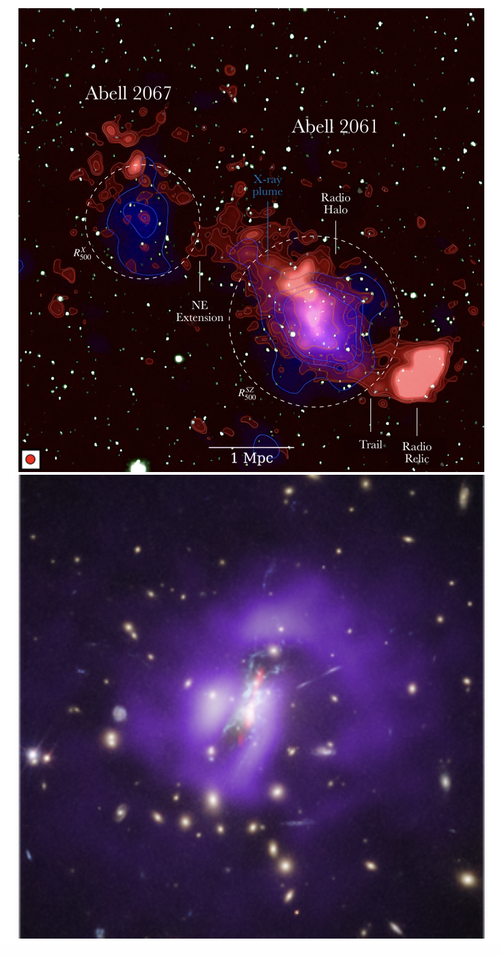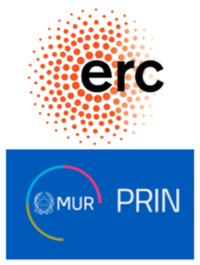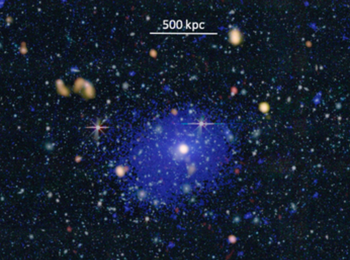Clusters of galaxies: gas thermodynamics, magnetic fields and relativistic particles

Galaxy clusters and the cosmic web a significant fraction of "non-thermal" energy, i.e. in the form of magnetic fields, relativistic particles and kinetic energy associated with the turbulent or regular motions of the plasma. Radio observations show a variety of structures spread over millions of light years, called "halos", "relics", "mini-halos" e "mega-halos" in galaxy clusters, and are fundamental to understanding the mechanisms of acceleration of relativistic particles. Other emissions even more peripheral, recently discovered, such as "bridges" between galaxy clusters, are fundamental to the study of the plasma before its accretion into the clusters. Radio emission is observable thanks to the interaction of relativistic particles with magnetic fields, and recent observations have revealed traces of magnetic field on scales even larger than clusters, in filaments of galaxies. The study of magnetic fields in clusters and filaments will clarify the origin of the magnetic field in the Universe and the processes that lead to its amplification.
In addition to the accretion of matter, the mechanical feedback from AGN, associated with the complex interaction between hot gas and cold molecular gas in galaxies, dramatically modifies the thermodynamics of the gas in galaxy clusters, balancing the effect of X-ray energy radiation, mixing the gas in the densest regions and transporting relativistic particles and magnetic fields over the entire cluster volume.
Our group studies and observes the evolution of cosmic structures, and of their magnetic field, combining advanced cosmological simulations (produced for example at CINECA ) with observations from radio (for example with JVLA, LOFAR, uGMRT, MeerKAT, ASKAP), to microwaves (for example with ALMA) up to the highest frequencies (in X-rays with Chandra, XMM and XRISM), also in preparation for the advent of the Square Kilometre Array (SKA), the largest telescope ever built by humanity.
The list of Master's theses currently available from this group is available at the bottom of the page.
DIFA staff members
Annalisa Bonafede
Associate Professor
Fabrizio Brighenti
Associate Professor
Virginia Cuciti
Junior assistant professor (fixed-term)
Daniele Dallacasa
Associate Professor
Gabriele Giovannini
Alma Mater Professor
Myriam Gitti
Associate Professor
Carlo Nipoti
Associate Professor
Franco Vazza
Associate Professor

Funding & Grants
- ERC Grants no. 714196 “MAGCOW” , PI. F.Vazza (2017-2023)
- ERC Grants no. 714245 “DRANOEL” , PI A. Bonafede (2017-2023)
- Grant from Fondazione Cariplo, "BREAKTHRU", PI. F.Vazza (2023-2025)
- PRIN no. J53D23001610006, "AGN-sCAN", Responsabile locale: M. Gitti (2023-2025)
- ERC Consolidator no. 101169773 "BELOVED", PI A. Bonafede (2025-2030)
DIFA post-doc and PhD students
Marco Balboni
Research fellow
Tommaso Bartalesi
PhD Student
Salome Mtchedlidze
Research fellow
Annalisa Pagliotta
PhD Student
Anton Rudakovskyi
Research fellow
Stefano Sotira
PhD Student
Main Collaborations
-
Radio Astronomy Institute (IRA) of INAF
Main Collaborators: G. Brunetti, E. Carretti, T. Venturi, R. Cassano, A. Botteon, F. Degasperin, C. Stuardi, M. Brienza, G. Di Gennaro, T. Pasini, C. Gheller, K. Nishiwaki
-
Astrophysics and Space Science Observatory (OAS) of INAF
Main collaborators: S. Ettori, F. Finelli, D. Paoletti, M. Sereno, M. Roncarelli, C. Giocoli
-
Astronomical Observatory, University of Hamburg
Main collaborators: M. Brueggen, G. Lusetti, V. Heesen
-
Center for Astrophysics – Harvard & Smithsonian (USA)
Main collaborators: E. O’Sullivan, K. Rajpurohit, G. Schellenberger, W. Forman, P. Dominguez-Fernandez

AVAILABLE MASTER THESIS PROJECTS
-
Abell795. JVLA radio observations of radio galaxies. Goals: Map the central radio galaxy of Abell 795 and study the properties of the radio galaxies in the cluster. Contacts: F. Ubertosi, M. Gitti, F. Brighenti
-
Abell 795: deep Chandra X-ray obs. of the intracluster medium. Goals: use X-ray Chandra data to investigate the presence of X-ray cavities (→ feedback) in the core of the cluster, Study dynamics of sloshing (bulk motions) of the intracluster medium. Contacts: F. Ubertosi, M. Gitti, F. Brighenti
-
Misaligned jets and X-ray cavities: linking pc and kpc scales . Goals: use VLBA data to measure the size and direction of propagation of the radio jets at very high spatial resolution (parsec scales, close to the BH!). Compare the jet direction with the cavities in the intracluster medium and verify how frequently jets are reoriented Contacts: F. Ubertosi, M.Gitti ,
-
Radio galaxy evolution and feedback in a merging cluster at z~0.5 Goals: use JVLA and VLBA data to search for extended radio lobes of the central radio galaxy, and their interaction with the ICM 2. Spectral study of the central radio source → renewed AGN activity? Activation connected with merger? Contacts: F. Ubertosi, M. Gitti, F. Brighenti
-
The circumgalactic multi-phase gas in ZwCl 235 Goals: use VLT/MUSE data to study the distribution and extent of cool gas in the central galaxy of a galaxy cluster 2. Connection with cooling of the intracluster medium. Contacts: F. Ubertosi, M. Gitti, F. Brighenti
-
Simulations of AGN feedback, turbulence in clusters & galaxies. Goals: study numerical simulations of AGN feedback to perform turbulence analysis, cavities & shcoks studies, and compare with observations. Contacts: F. Brighenti , F.Vazza
-
Radio emission and magnetic field in galaxy clusters and beyond using LOFAR. Goals: use new radio data to study the statistical properties of cluster samples at low frequency, using LOFAR survey data. Contacts: A.Bonafede
-
Radio emission and magnetic field in galaxy clusters and beyond using MEERKAT. Goals: use radio polarisation data to study magnetic fields in low-mass clusters, and develop numerical techniques to analyse magnetic fields from polarisation. Contacts: A.Bonafede